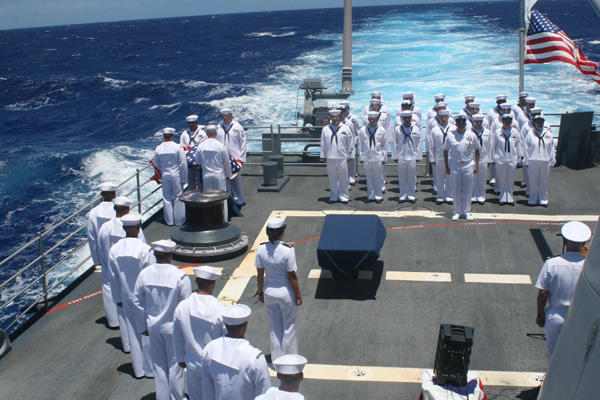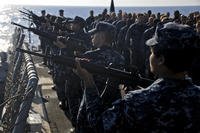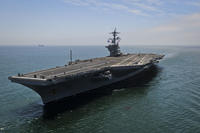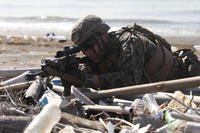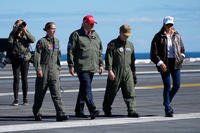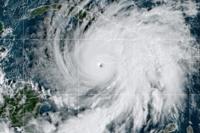The tradition of burial at sea is an ancient one. As far as anyone knows this has been a practice as long as people have gone to sea. In earlier times, the body was sewn into a weighted shroud, usually sailcloth. The body was then sent over the side, usually with an appropriate religious ceremony. Many burials at sea took place as recently as World War II when naval forces operated at sea for weeks, and months at a time. Since World War II many service members, veterans, and family members have chosen to be buried at sea.
Ceremonial Procedure for at Sea Disposition
Personnel participating or attending the services must wear the Uniform of the Day. When a chaplain of appropriate faith is not available, the service may be read by the commanding officer or an officer designated by him/her. The committal service is as follows:
- Station firing squad, casket bearers and bugler.
- Officer's call. Pass the word "All hands bury the dead" (the ships should be stopped, if practicable, and colors displayed at half-mast.
- Assembly.
- Adjutant's call (Call to Attention).
- Bring the massed formation to Parade Rest.
- Burial service.
- The Scripture (Parade Rest).
- The prayers (Parade Rest, heads bowed).
- The Committal (Attention, Hand Salute).
- The Benediction (Parade Rest, heads bowed).
- Fire three volleys (Attention, Hand Salute).
- Taps. Close up colors. Resume course and speed at the last note of Taps (Hand Salute)
- Encasing of the flag (Attention).
- Retreat (Resume normal duties).
Officers in the funeral procession and casket bearers may wear the mourning band on the left arm.
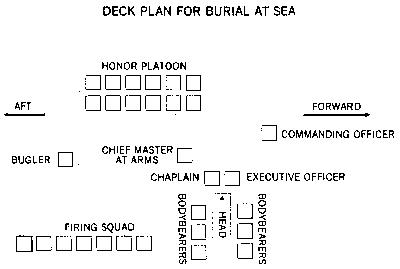
Preparation for the at Sea Disposition
Casketed Remains from a Naval Ship
There are two component parts of the ceremony of at sea disposition: religious and military. The reading of the scripture and prayers, the committal, and the benediction constitutes the religious part and may be performed by the chaplain, commanding officer, or an officer designated by him/her. All other aspects of the ceremony are performed by other military personnel.
For at sea disposition, the casketed remains are covered with the national ensign with the union placed at the head and over the left shoulder. When draped with the national ensign, the cap and sword of the deceased are not displayed.
Six or eight casket bearers (depending on the weight of the casketed remains) form according to height on both sides of the casket. Below decks, while not carrying the casket, casket bearers will uncover. At all other times they remain covered. The casket is always carried feet first.
The selected place for committal is cleared and rigged so that when the casket remains are brought on deck they may be placed securely on a stand, if necessary, with feet overboard at right angles to and extending over the side of the launching.
Attention is sounded on the bugle or passed by word of mouth as the casket bearers, preceded by the chief master-at-arms, execute the Hand Salute as the cortege passes to the place selected for the committal. When the remains have been so placed, the Hand Salute is terminated by those in view and a sentry is posted unless the burial service is to follow immediately.
A chief petty officer is designated to take charge of the firing party of seven persons. The chief master-at arms directs the casket bearers during the service until the flag is encased and delivered to the commanding officer.
Cremains from a Naval Ship. In cases where the remains have been cremated and the urn containing the ashes has been received on board for a sea disposition, the following procedures will govern:
If the urn is to be opened and the remains scattered at the time of committal, a small table or stand should be securely rigged beforehand at the selected place for the committal. The urn will be placed on this table or stand during the reading of the service. The folded flag will be placed on the stand beside the cremains. The executive officer, or an other officer appointed by the commanding officer, will assume responsibility for opening the urn and scattering the remains at the appropriate time (keeping in mind the wind factor) during the committal ceremony.
If the urn is not to be opened, a small platform should be constructed and rigged so that during the service, the urn may rest thereon and be launched at the time of committal by tilting up the inboard end of the platform, thus permitting the urn and cremains to slide overboard into the sea.
The cremains received for committal at sea will sometimes be accompanied by floral tributes which may be used to surround the receptacles and cover the platform or table on which it rests during the service. The flowers may be permitted to slide overboard with the cremains or be tossed into the sea by the flag bearer after the urn has been launched or the cremains have been scattered.
For all phases of the funeral where the cremains are carried by hand, one enlisted member will be detailed to carry the receptacle containing the remains.
Four enlisted members will be detailed as flag bearers and will also serve as urn bearers. The flag bearers will follow the bearer of the urn as it is brought on deck and carried to the place of committal. The folded flag will be carried by the leading flag bearer on the right. The flag is then placed on the stand beside the cremains. Immediately prior to scattering the cremains or committal of the urn to the sea, the flag will be picked up and held by the leading flag bearer until completion of Taps, at which time the flag will be presented to the commanding officer.The Ceremony for at Sea Disposition (Casketed Remains).
When the honor platoon has been assembled in massed formation and has been brought to parade rest, the burial service is begun and read through to the end of the prayers. During prayers the assemblage remains covered with bowed heads. After the conclusion of the prayers the casket bearers should hold the casket and national ensign in place by hand as may be necessary before reading the committal.
When these preparations have been completed and all is in readiness, attention is sounded. The command "Firing party, Present Arms" (Honor platoon Hand Salute) is given and the reading of the committal is commenced. When the indicated word of the committal is read, the casket bearers tilt the board until the casket slides along it, under the national ensign, overboard into the sea. As it goes, the casket bearers retain the board and the national ensign on board and stand fast.
The command "Firing party, Order Arms, Parade Rest," are given and all hands bow their heads. The benediction is pronounced. Then follow the commands, "Firing party, Attention. Fire three volleys" (Honor platoon Hand Salutes and remain so until the last note of Taps) "Ready, aim, fire; aim, fire; aim, fire." After the last volley the firing party remains at the ready position, pieces locked, until the conclusion of Taps, and salutes.
Upon completion of Taps, the firing party is brought to Order Arms. The casket bearers encase the national ensign by folding twice along the long axis of the flag. The blue field is kept to the outside. Beginning at the fly end (away from the blue field), the flag is folded with only the blue field showing. It is then presented by the chief master-at-arms to the commanding officer.
After the commanding officer has received the flag and has departed, the command Parade Rest is given, and when all have assumed it, the details (firing party and casket bearers) are brought to Attention, formed and marched away. When they are clear, the honor platoon is brought to Attention, retreat sounded and the ceremony is over.
Information Provided the Next of Kin After Committal Services Completed
Disposition at sea is normally accomplished within 8 to 10 weeks from the time the responsible Fleet Commander-in-Chief is notified of a request.
The Commanding Officer of a ship directed to conduct an at sea disposition will, within 10 days after the committal, mail to the next of kin a personal letter giving the date and time of committal and include photographs or video tape of the ceremony, the commemorative flag and a chart showing where the burial took place. Copies of the basic letter only will be forwarded to Naval Office of Medical/Dental Affairs, Great Lakes, IL; and Bureau of Medicine and Surgery, Washington DC.
Dispersion of Cremains from an Aircraft
Private memorial services and/or honors should be accomplished prior to forwarding requests for cremains dispersion from an aircraft. Appropriate coordination with a naval activity capable of accomplishing disposition by this means should be arranged. The next of kin shall be informed by letter from the commanding officer or if appropriate the chaplain, advising them when and where (by grid coordinates) disposition was accomplished.
Eligibility
Active duty, retired, honorably discharged veterans and their family members, U.S. civilian marine personnel of Military Sealift Command, other U.S. citizens who are determined eligible by the Chief of Naval Operations because of notable service and/or other contributions to our government.
Anyone desiring burial at sea should indicate that preference in writing (in a will or other legal document). During funeral planning, the executor/executrix of the estate should contact:
Military Medical Support Office (MMSO)
Mortuary Affairs, Bldg 38H
Great Lakes IL 60085-5200
Toll Free: 1-888-647-6676
For further information visit: www.public.navy.mil/bupers-npc/support/casualty/mortuary/Pages/BurialAtSea.aspx
Bibliography
Mack, William P. and Royal W. Connell. Naval Ceremonies, Customs, and Traditions. Annapolis MD: Naval Institute Press, 1980. [See "Burial at Sea," pp. 175-180 and "Firing Three Volleys at Funerals," pp. 180-181 for useful historical background].
Navy Military Funerals (NAVPERS 15555C). Washington DC: U. S. Government Printing Office, 1993. [Includes descriptions of services for committal of persons of the Protestant, Catholic, Jewish, Eastern Orthodox, Muslim, and Buddhist faiths. The above information on ceremonial procedures for at sea disposition was taken from the pamphlet].
United States Navy Regulations. Washington: Department of the Navy. [see Chapter 12, "Deaths and Funerals." This does not include a detailed description of the ceremony.].
